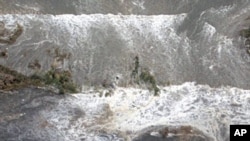A tsunami is a series of large waves generated by an abrupt movement on the ocean floor that can result from an earthquake, an underwater landslide, a volcanic eruption or - very rarely - a large meteorite strike.
However, powerful undersea earthquakes are responsible for most tsunamis. Seismologists say only earthquakes measuring greater than 7.0 on the Richter scale can produce a major tsunami.
Most earthquakes that generate tsunamis - including Friday's jolt off Japan's eastern coast - occur in areas called subduction zones, where pieces of the Earth's crust press against each other. Subduction means that one tectonic plate slides beneath another and sinks deep into the Earth's mantle.
The friction between two slow-moving plates of the Earth's crust creates vast amounts of seismic energy which is released in the form of an earthquake. When a strong undersea earthquake strikes a relatively short distance below the sea floor, it abruptly pushes up one of the immense plates of the Earth's crust. That suddenly displaces an enormous amount of ocean water which becomes a tsunami, spreading outward in every direction from the epicenter of an earthquake - like ripples on a pond, only on a much larger scale.
Tsunamis generated in the open ocean appear to be only small waves, but they can grow rapidly in size as they reach shallow water before crashing into seacoast settlements. Waves up to nine meters high have been recorded on numerous occasions, and tsunamis up to 30 meters high are believed to have occurred in the past.
Damage is usually worst in areas closest to the undersea quake, often because the fast-moving waves will hit land so quickly. Tsunamis radiate out from the site of an undersea quake nearly as fast as a jet airliner can travel, but because the expanse of the Pacific is so wide, alert systems are in place to sound a warning to those in the path of an advancing wave.
The term tsunami comes from two Japanese words that mean "harbor" and "wave."
What Causes a Tsunami?










